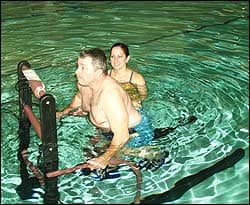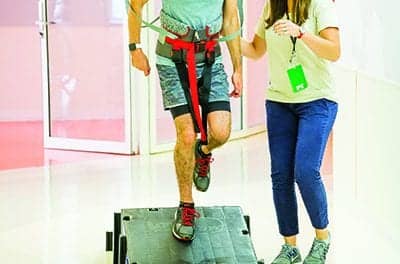 |
| Author Sara Kittell, MSPT (left), oversees patient Alan McClure, who works out on an underwater treadmill at Good Shepherd Rehabilitation Network’s aquatic therapy center. |
It is common knowledge that swimming is the one exercise in which more muscles are used in harmony with one another than in any land-based physical activity. The transition from sports activity or healthy exercise to aquatic therapy was a natural evolution. Now, water-based therapy is universally accepted as a primary treatment and rehabilitation prescription for a variety of physical conditions. Indoor therapy sessions in heated pools are a source of major relief for millions of Americans, as more and more turn to this minimally invasive therapy for improving their flexibility, range of motion, and overall strength.
AQUATIC THERAPY GOALS
Aquatic therapy provides a unique and significant niche in the rehabilitation process and a supportive environment for exercise for patients who are unable to tolerate land-based activity without the exacerbation of their symptoms. In the water, weight bearing is reduced through buoyancy, thus decreasing stress and pain through the joints. Proprioception and balance reactions can be challenged by the turbulence and drag created by movement through the water. Progressive resistance training can be performed while simultaneously challenging postural stability by using the properties of water.
One of the numerous positive outcomes of aquatic therapy is that the aquatic environment allows patients to do activities or assume positions that they have not been able to achieve for some time as, on land, their bodies operate against the forces of gravity, thereby frequently contributing to pain. Another goal of aquatic therapy is to stimulate the circulation of synovial fluid, which provides lubrication in the joints. This fluid is circulated via movement and, in many instances, this is most easily attained in an aquatic environment.
WHY AQUATIC THERAPY
“Aquatic therapy is beneficial for patients [throughout their lives],” says Annette Span, PTA, at Good Shepherd Rehabilitation Network, Allentown, Pa, who has more than 15 years of aquatic experience. “At any given time we treat children with developmental disabilities, adults as well as those with geriatric orthopedic conditions.” In fact, the facility recently opened a new 30 foot by 50 foot heated indoor aquatic therapy pool, enabling a significant increase in its capacity to provide aquatic therapy. The pool is housed in the hospital system’s new $20.8 million Health and Technology Center.
Aquatic therapy allows for assisted movement earlier than might be tolerated on land—when early range of motion exercises may be indicated, such as with a shoulder or knee injury. In addition, water activities can be fun, especially for children. Buoyancy is an excellent tool for assisting flexion-based extremity exercise. Manual stretching activities also can be performed in a supported supine position, as they would be on land, but with the added buoyancy that only water can provide. Common conditions treated in Good Shepherd’s aquatic pool include athletic injuries, spinal cord injuries, CVA (stroke), and chronic pain. Other conditions treated are rheumatology conditions, such as fibromyalgia or rheumatoid arthritis, and degenerative conditions, such as osteoarthritis or degenerative disc disease.
THERAPY REGIMEN
Each client entering the aquatic therapy program at Good Shepherd is individually evaluated by a physical therapist, who in turn creates a customized therapy regimen for that person. Group exercise maintenance classes are typically offered following discharge and are administered by the recreational therapists and fitness staff.
One-on-one therapy is performed to achieve goals such as controlled movement, improved gait or transfer patterns, or proprioceptive retraining. Among neurological patients, many deficits, including poor balance, neglect, partial paralysis, increased tone, and impulsivity, require one-on-one. Pediatric patients also respond well with one-on-one therapy, which provides constant stimulation and different play options to retain active participation. Therapy usually lasts 45 to 60 minutes.
One of the effective treatments performed in Good Shepherd’s pool involves the supported supine position, as in the Bad Ragaz ring method. Momentum is applied by the therapist onto the patient with variations in speed, the length of lever arms, and the angle of force application, to achieve increased proprioception, strength, stability, and range of motion, or even decreased pain. For example, a patient with a history of low back pain and poor ability to use their abdominal and paraspinal musculature properly to stabilize the back with dynamic activities would be an excellent candidate for this treatment.
To begin, the patient would be positioned in a supported supine position at the surface of the water, with flotation at the neck, pelvis, and lower legs, with arms held straight and tightly at the sides and legs held together with knees straight. To increase trunk stability and improve proprioception through the trunk, the therapist’s hands can initially be placed beneath the scapulae while laterally gliding the patient slowly over the surface of the water.
Verbal cues to isometrically tighten the body, with careful observation to assure proper muscle activation through the core, are imperative to successful treatment. As the patient’s ability to stabilize the trunk improves, speed can increase, hand placement of the therapist can move distally, and the patient’s extremities can be positioned away from midline during lateral glides. Lateral movement also can be advanced to diagonals, which are more representative of functional patterns.
In most instances patients are recommended for two or three therapy sessions a week, with the duration of the therapy depending on individual patient needs. For example, a person who was inactive for years due to chronic back pain and who had recently undergone a lumbar fusion and was overweight, is likely to require more extensive therapy following surgery. On the flip side, a relatively fit woman who just had arthroscopic knee surgery to “clean up” arthritis is likely to require far less therapy. The overall health of a patient, weight considerations, and overall activity level prior to therapy will always influence the duration of therapy. “Osteoarthritic conditions are among the most commonly treated in Good Shepherd’s pool, along with patients with arthritic conditions post surgery,” says Span. Range of motion, core stability, endurance, and proper gait patterns are commonly addressed.
“The uncommon and most challenging conditions tend to be the autoimmune or rheumatic conditions that affect several systems and often have strong pain correlations,” adds Span. Examples of these conditions are complex regional pain syndrome and lupus. The goals for these patients would be to manage their chronic conditions and maximize function. A solid discharge plan is necessary for maximal benefit from therapy. This could take the form of the continuation with an independent aquatic exercise routine or planned participation in an aquatic fitness class, both of which are complemented by a land-based home program as tolerated.
The therapists at Good Shepherd use a variety of aids in their therapy sessions. These include flotation rings, noodles, belts and barbells, resistance paddles, and cuff weights. Beach balls and other toys are used for balance activities, and kickboards are used by those needing to gain more extension in their legs. Therapy in the pool is always supervised by a licensed PT or PTA.
Aquatic therapy is available to both inpatients and outpatients, and Good Shepherd also provides fitness or recreational therapy programs that are open to the general public at their new outpatient facility.
Aquatic therapy has become far more widespread in recent years, and indications are that it will continue to gain momentum as an exercise and rehabilitation medium. It is increasingly being used to treat athletic injuries, and many wellness programs recognize the benefits of aquatic therapy. Pilates and yoga routines have been modified for practice in aquatic environments, and this is a trend that is expected to grow.
Sara Kittell, MSPT, is a physical therapist, specializing in aquatic therapy, at Good Shepherd Rehabilitation Network, Allentown, Pa. For more information, contact
PORTABLE THERAPY |
|
The Boons and Burdens of Off-Site Aquatics Programs by Stephen Krcmar Do you want to offer aquatic therapy but find yourself without a pool? Do not let it stop you. There are plenty of options out there that include renting pool time, purchasing a temporary unit, building an inground pool, and even bartering your services for pool time. The latter is often successful at condominium complexes. Offering an occasional class, like water walking, that all tenants can use may earn you access, says Ruth Sova, MS, president of Aquatic Therapy & Rehab Institute, Port Washington, Wis. Working with a client who lives in the complex is another way to get into condo pools. This is preferable because access in these situations is usually offered with no strings attached. Possibilities for pool rentals include hotels, park and recreation departments, Jewish community centers, and schools. Many of these pools are in use during times that fitness centers are busy—early in the morning, after 5 pm, and sometimes during lunch—and empty during traditional working hours for therapists. The benefits of renting a pool include not having to worry about costly maintenance. But there are sacrifices too. “The drawback is you have no control [over the owner’s decisions],” Sova says. “They can suddenly decide to either drain the pool, or rent it out for a birthday party.” Most pools that are not rehabilitation specific have cooler water temperatures—often much cooler than 92 degrees, the temperature favored by many therapists. Lower temperatures do not make aquatic therapy impossible. With some additional equipment like “wet wraps” to keep vital organs warm—as well as neoprene booties—the coldness can be overcome. A little planning helps too: Sova says that arranging appointments during mid-morning hours or the early afternoon is best because during these times people are naturally warm. In past decades, ladders were the only option for easing into a pool or getting out. In many cases patients were physically unable to use ladders and lifts were necessary to get clients into and out of the water. The Americans with Disabilities Act changed regulations, and now facilities are more accessible because there are options like steps in addition to ladders. Decreased dependence on lifts means some therapists can forgo purchasing this piece of equipment that costs roughly $5,000. Therapists of rehabilitation centers who are starting a new aquatic therapy practice need to spend only a fraction of that. BUDGETARY FACTORSAn initial investment of about $1,000 will cover the costs of necessary equipment that may include flotation rings (to make floatation safer and to add buoyancy), floatation belts (for vertical positioning or to correct alignment), hollow barbells (to provide water resistance when empty or weight when filled), buoyant hand bars (to provide balance and stability when walking as well as a workout for the core and upper body), short-tipped fins and flippers (for ankle rehabilitation), resistance bands and tubing (to add resistance to training), and kick boards (for stabilization exercises). This significant selection of equipment can be another drawback for those who rent pools, because storage is rarely included in these situations, so therapists have to haul these devices with them. Some rehabilitation centers that do not own the property where their offices are located elect to go with aboveground pools because it is possible to remove them. Temporary pools are a more mobile option. These units cost about $5,000, according to Sova, and can be built or broken down in a few hours. Those with additional funds may want to consider building an inground unit. This is more expensive, of course, but is often reasonable when it is part of a larger installation like building a lap pool. USA Swimming (www.usaswimming.org) offers consultations on how to become part of larger construction projects like this and advises members on its Web site: “Never build a single use facility. Explore all possibilities for community service and aquatic programming.” This is good news for rehabilitation professionals. Communities are interested in building more than pools. They want wellness centers, and they need you for that. Stephen Krcmar is a contributing writer for Rehab Management. |





